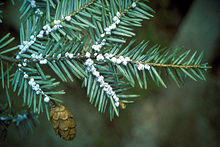| Hemlock woolly adelgid | |
|---|---|

| |
| Hemlock woolly adelgid on western hemlock (Tsuga heterophylla) | |
| Scientific classification | |
| Domain: | Eukaryota |
| Kingdom: | Animalia |
| Phylum: | Arthropoda |
| Class: | Insecta |
| Order: | Hemiptera |
| Suborder: | Sternorrhyncha |
| Family: | Adelgidae |
| Genus: | Adelges |
| Species: | A. tsugae
|
| Binomial name | |
| Adelges tsugae Annand, 1928
| |


Adelges tsugae, the hemlock woolly adelgid (/əˈdɛl.dʒɪd/[1]) or HWA, is an insect of the order Hemiptera (true bugs) native to East Asia. It feeds by sucking sap from hemlock and spruce trees (Tsuga spp.; Picea spp.). In its native range, HWA is not a serious pest because populations are managed by natural predators and parasitoids and by host resistance.[2] In eastern North America it is a destructive pest that threatens the eastern hemlock (Tsuga canadensis) and the Carolina hemlock (Tsuga caroliniana). HWA is also found in western North America, where it has likely been present for thousands of years. In western North America, it primarily attacks western hemlock Tsuga heterophylla and has only caused minor damage due to natural predators and host resistance.[2] Accidentally introduced to North America from Japan, HWA was first found in the eastern United States near Richmond, Virginia, in 1951.[2] The pest is now found from northern Georgia to coastal Maine and southwestern Nova Scotia as well as areas of western Michigan near the eastern Lake Michigan shoreline.[2][3] As of 2015[update], HWA has affected 90% of the geographic range of eastern hemlock in North America.[4]
- ^ "Definition of adelgid | Dictionary.com". www.dictionary.com.
- ^ a b c d Government of Canada, Canadian Food Inspection Agency (3 January 2012). "Adelges tsugae (Hemlock Woolly Adelgid) – Fact Sheet". www.inspection.gc.ca.
- ^ "Invasive Species: Hemlock Woolly Adelgid". Michigan Invasive Species. Michigan Invasive Species Program. Retrieved 2 March 2024.
- ^ Kok, Loke T.; Salom, Scott M.; et al. "Biological Control of the Hemlock Woolly Adelgid". Virginia Tech College of Agriculture and Life Sciences, Department of Entomology. Archived from the original on 28 August 2006.